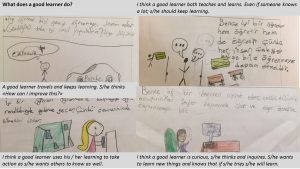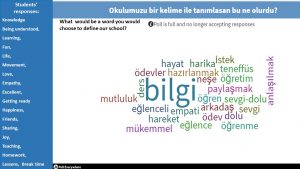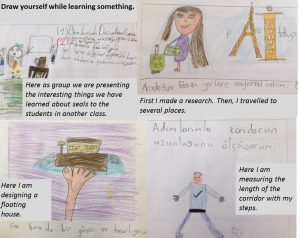This article is about the ways a PYP school in Turkey uses students’ feedback to enhance the current school practices related to curriculum, learning and teaching.
Feedback to feed-forward – crucial for progress. As educators we keep records of our students’ progress throughout the year and give written and oral feedback in order to identify learning goals and next steps. Students also give feedback to their peers – a great way to learn from each other. However, I believe that opportunities for students to take the lead and give feedback to their teachers and school are not given as often.
 With the enhancements in the PYP, “agency” has become a concept that we focus on to reflect on our current practices. Choice, voice and ownership – “What are the students’ perceptions on these? Are they agents of their own learning? How?” I think schools and teachers need to get feedback from students more often to set new goals about their practices and to enable students to demonstrate agency.
With the enhancements in the PYP, “agency” has become a concept that we focus on to reflect on our current practices. Choice, voice and ownership – “What are the students’ perceptions on these? Are they agents of their own learning? How?” I think schools and teachers need to get feedback from students more often to set new goals about their practices and to enable students to demonstrate agency.
 In our school we have been getting feedback from our students via different tools that we created in 2014 and have used each year since then. Inspired by Carla Marschall’s presentation “Involving Students In Curriculum Evaluation” at the IB Regional Conference in 2014, we started getting students’ responses to prompts and questions related to life at school, our curriculum and teaching and learning practices. In the first years, we used feedback forms with questions that allowed students to give written or drawn responses. We identified the questions with a group of teachers. Our aim was to use the rich data that we collect from our students to improve our practices. For the past five academic years we have completed the year with a feedback form from the students, then a study on their responses and reflections. Each year we revise the questions and the tools according to our needs.
In our school we have been getting feedback from our students via different tools that we created in 2014 and have used each year since then. Inspired by Carla Marschall’s presentation “Involving Students In Curriculum Evaluation” at the IB Regional Conference in 2014, we started getting students’ responses to prompts and questions related to life at school, our curriculum and teaching and learning practices. In the first years, we used feedback forms with questions that allowed students to give written or drawn responses. We identified the questions with a group of teachers. Our aim was to use the rich data that we collect from our students to improve our practices. For the past five academic years we have completed the year with a feedback form from the students, then a study on their responses and reflections. Each year we revise the questions and the tools according to our needs.
Every year we ask our students what single word they would use to define our school. (This is such a simple but a very strong prompt especially when used with a Web 2.0 tool that instantly shows the responses.) This year we got responses such as learning, movement, being undertood, life, sharing, love, fun, happiness, empathy, knowledge – that made us pleasantly surprised as these were what we were trying to emphasize in our school with our current practices. What we aimed at was how they felt about our school.
We ask them what they wanted to do more at school and their responses guide us in offering the extra curricular activities and in providing them room for leading their own interest clubs.
“If you had a chance to plan a unit for your class, what would it be?” is another question that we ask our students. Their responses provide us data that we can use in evaluating and reviewing our programme of inquiry.
“How do you learn best? and “Draw yourself learning something.” are prompts that make us reflect on our teaching practices. We learn how aware they are about their own learning and how active they are in the learning process. We are able to see if they feel passive in the lessons – just listening to their teachers or if they have a more active role – working on a project, sharing ideas, presenting, experimenting etc. Their drawings allow us to see if they work individually or as a group while learning. We are able to see if they connect learning just to school or are aware of the fact that it happens everywhere. This has been a great tool for reflection. Their responses help us to set goals to become a more student centered school each year. When we take a look at the responses from this year and compare them to the ones that we got from the previous years, it is clear that we have made huge progress.
This year with the enhancements in the PYP, we felt that we had to provide more opportunities for the students to share their opinions about our curriculum and school life. Like many schools we also have a student council that is very active. However, in these meetings most of the time we hear the contributions of the same students representing their classes. We wanted to hear other students – or more students who were willing to share their ideas or had a project in mind and needed support, etc. For this reason, we have started leading meetings every month with a different group of students from each class. Sometimes these were single grade level meetings and sometimes multi grade level meetings. In single grade level meetings we wanted to get students’ feedback about their current units of inquiry – what they enjoyed learning about and what they wished to learn more about. Their responses were very useful for planning when we evaluated them together with their questions on the wonder walls of their classrooms and their teachers’ observations during the lessons.
In ISTEK Barış Schools we see our students’ feedback as an excellent tool to set new goals for our current practices. Everything at the school is for our students, so we really need to think about more ways to include students’ voice in the teaching and learning process and in general life at school.
References:
Involving Students in Curriculum Evaluation; Carla Marschall, IB Regional Conference, Rome 2014
Making the PYP Evaluation Process Meaningful, Carla Marschall, The Sharing PYP Blog, 2013
Ceni Alpanda is the PYP Coordinator of ISTEK Baris Schools in Istanbul, Turkey and Coordinator of ISTEK Schools’ PYP Coordinators. She is an IBEN member; with the roles of PYP workshop leader, school visit team leader, consultant and reader and IB Education workshop leader. She is passionate about PYP and feels privileged to be a part of a large network of PYP educators that helps her learn and grow every day. You can follow her on Twitter @CeniAlpanda.




No comments yet.